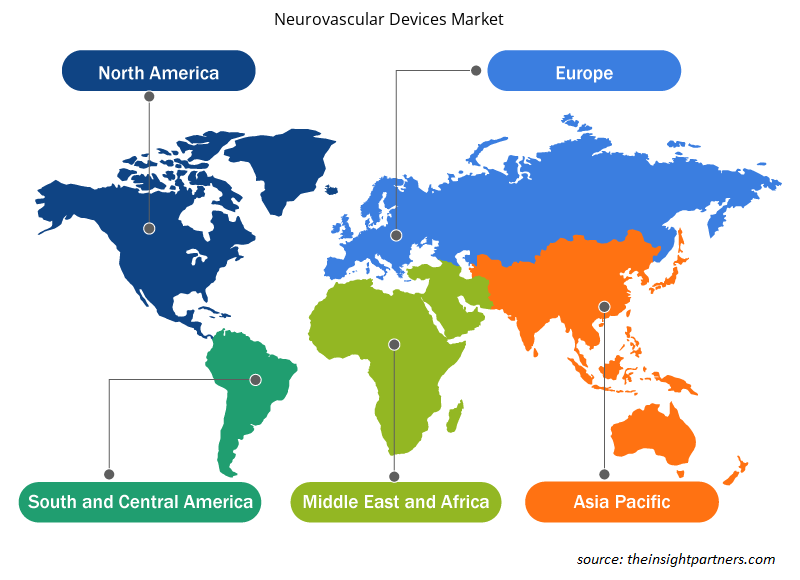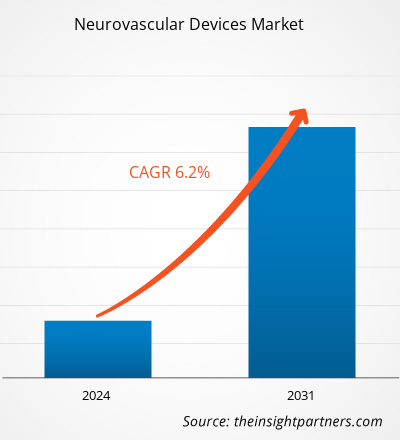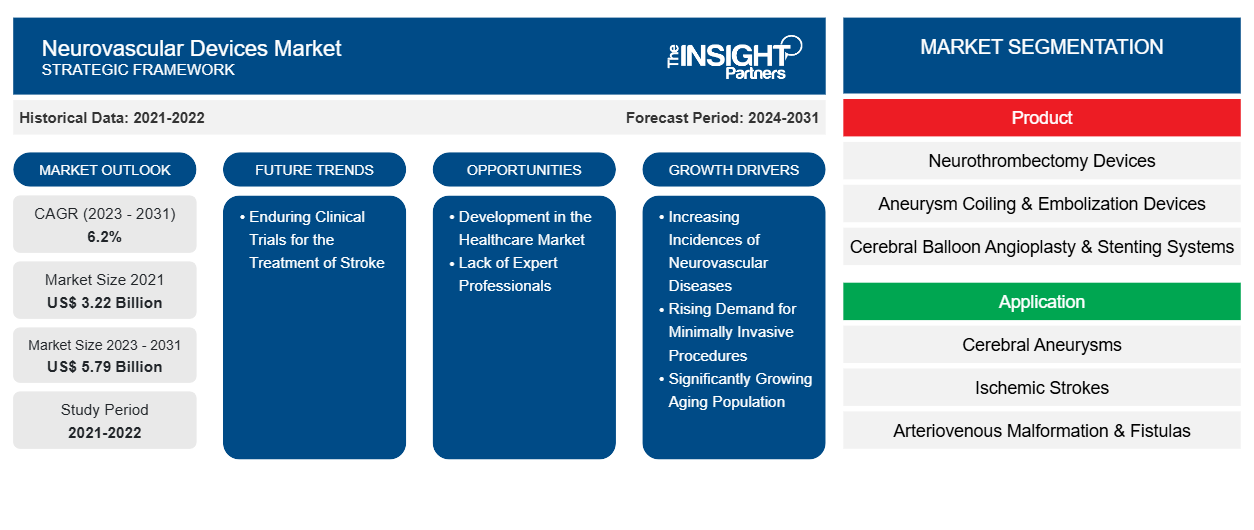En 2021, le marché des dispositifs neurovasculaires représentait 3,22 milliards USD et devrait atteindre 5,79 milliards USD d'ici 2031, contre XX milliards USD en 2023. Le marché devrait enregistrer un TCAC de 6,2 % en 2023-2031. La multiplication des essais cliniques en cours et la prévalence croissante des cas d'accident vasculaire cérébral dans les économies développées et en développement devraient rester les principales tendances du marché des dispositifs neurovasculaires.
Analyse du marché des dispositifs neurovasculaires
Les techniques d'imagerie avancées et les procédures mini-invasives ont permis aux professionnels de la santé d'effectuer des procédures plus précises et moins invasives, réduisant ainsi les risques associés aux approches chirurgicales traditionnelles. La prévalence croissante des maladies neurologiques est l'un des facteurs critiques de la croissance du marché des dispositifs neurovasculaires. Des facteurs tels que le vieillissement de la population et l'évolution des modes de vie ont entraîné une incidence accrue de maladies telles que les accidents vasculaires cérébraux et les anévrismes cérébraux, soulignant encore davantage la nécessité d'interventions neurovasculaires. En outre, il y a eu une évolution substantielle vers des techniques et des dispositifs mini-invasifs, réduisant ainsi le caractère invasif des procédures neurovasculaires. Cette évolution a entraîné des séjours hospitaliers plus courts, des temps de récupération plus rapides et des coûts de santé inférieurs pour les patients, rendant ces procédures plus accessibles et plus attrayantes pour les patients et les prestataires de soins de santé. Ces avancées technologiques et médicales ont collectivement contribué à la croissance impressionnante du marché des dispositifs neurovasculaires et à l'amélioration des soins et des résultats pour les patients.
Aperçu du marché des dispositifs neurovasculaires
Les dispositifs neurovasculaires traitent les maladies des artères sanguines qui alimentent le cerveau en sang riche en oxygène. En cas d'anévrisme complexe, des dispositifs de thrombectomie neurovasculaire sont utilisés pour retirer le caillot à l'origine de l'AVC. De nombreux dispositifs endovasculaires, tels que les anses, les aspirateurs et les dispositifs d'extraction de caillots sanguins, entrent dans cette catégorie. Le marché est en expansion pour de nombreuses raisons, notamment le rythme rapide de l'innovation technique dans ce secteur. Les dispositifs neurovasculaires comprennent les systèmes de pose de stents, les dispositifs d'embolisation et les dispositifs de neurothrombectomie utilisés pour traiter les maladies neurovasculaires telles que les anévrismes cérébraux. La prévalence croissante de ces maladies dans la population et les initiatives gouvernementales croissantes visant à sensibiliser aux options de traitement devraient stimuler la demande de produits pour traiter ces maladies.
Personnalisez ce rapport en fonction de vos besoins
Vous bénéficierez d'une personnalisation gratuite de n'importe quel rapport, y compris de certaines parties de ce rapport, d'une analyse au niveau des pays, d'un pack de données Excel, ainsi que d'offres et de remises exceptionnelles pour les start-ups et les universités.
-
Obtenez les principales tendances clés du marché de ce rapport.Cet échantillon GRATUIT comprendra une analyse de données, allant des tendances du marché aux estimations et prévisions.
Moteurs et opportunités du marché des dispositifs neurovasculaires Devices Market Drivers and Opportunities
La demande croissante de procédures peu invasives devrait favoriser le marché
Les chirurgies mini-invasives connaissent une forte adoption en raison de leur attrait esthétique et de leurs temps de récupération plus courts, ce qui pourrait encore rationaliser l'expansion du marché des dispositifs neurovasculaires. Les procédures chirurgicales ont continuellement introduit des innovations et des améliorations pour les rendre plus sûres pour les patients. La chirurgie mini-invasive est devenue la norme pour les procédures chirurgicales traditionnellement réalisées à l'aide d'une technique ouverte. Ces procédures chirurgicales comprennent la chirurgie laparoscopique, la chirurgie endoscopique et la chirurgie robotique. La demande accrue de procédures neurochirurgicales mini-invasives, les connaissances croissantes des neurochirurgiens sur les procédures mini-invasives et l'augmentation des études de recherche dans le domaine de la thérapie neurovasculaire pourraient offrir des opportunités lucratives aux principaux concurrents dans la période à venir. De tels scénarios devraient favoriser le paysage industriel.neurovascular devices. Surgical procedures have continually introduced innovations and improvements to make them safer for patients. Minimally invasive surgery has become the standard for surgical procedures traditionally performed using an open technique. These surgical procedures include laparoscopic surgery, endoscopic surgery, and robotic surgery. The increased demand for minimally invasive neurosurgical procedures, the increasing knowledge of neurosurgeons about minimally invasive procedures, and the increase in research studies in the field of neurovascular therapy may provide lucrative opportunities for key competitors in the coming period. Such scenarios are expected to favor the industry landscape.
Stratégies de croissance croissantes – Une opportunité pour la croissance du marché des dispositifs neurovasculairesNeurovascular Devices Market Growth
L’intensification des stratégies de croissance organique, telles que l’approbation de produits par les autorités réglementaires pour élargir les portefeuilles de produits des principaux acteurs, devrait stimuler la croissance du marché. Par exemple, Scientia Vascular, une société américaine de dispositifs médicaux, a annoncé en mai 2021 avoir reçu un financement de 50 millions de dollars de Vivo Capital, une société d’investissement dans le secteur de la santé, pour développer des fils-guides et des microcathéters pour traiter les accidents vasculaires cérébraux. Les technologies innovantes continueront d’élargir la gamme d’outils neurovasculaires disponibles pour traiter divers types d’anévrismes de manière plus sûre et plus efficace. La gestion des anévrismes évolue constamment, avec une technologie sophistiquée à la pointe de l’innovation.Scientia Vascular, a US-based medical device company, announced in May 2021 that it had received $50 million in funding from Vivo Capital, a healthcare investment firm, to develop guidewires and microcatheters to treat stroke. Innovative technologies will continue to expand the range of neurovascular tools available to treat various types of aneurysms more safely and efficiently. Aneurysm management constantly evolves, with sophisticated technology at the forefront of innovation.
Analyse de segmentation du rapport sur le marché des dispositifs neurovasculaires
Les segments clés qui ont contribué à l’élaboration de l’analyse du marché des dispositifs neurovasculaires sont le produit, l’application et l’utilisateur final.
- En fonction du produit, le marché des dispositifs neurovasculaires est divisé en dispositifs de neurothrombectomie, dispositifs d'enroulement et d'embolisation d'anévrisme, systèmes d'angioplastie et de pose de stent par ballonnet cérébral et dispositifs de support. En 2023, le segment des dispositifs d'enroulement et d'embolisation d'anévrisme détenait la plus grande part du marché, et le même segment devrait enregistrer le TCAC le plus élevé au cours de la période de prévision. Le segment est en outre classé en bobines emboliques, bobines amovibles nues, bobines amovibles revêtues, dispositifs de dérivation de flux et agents emboliques liquides.
- En fonction des applications, le marché est segmenté en anévrismes cérébraux, accidents vasculaires cérébraux ischémiques, malformations et fistules artérioveineuses, etc. En 2023, le segment des accidents vasculaires cérébraux ischémiques détenait la plus grande part du marché, et le même segment devrait enregistrer le TCAC le plus élevé au cours de la période 2023-2031.
- En termes d'utilisateur final, le marché est segmenté en hôpitaux, centres de chirurgie ambulatoire et cliniques spécialisées. En 2023, le segment des hôpitaux détenait la plus grande part du marché et le même segment devrait enregistrer le TCAC le plus élevé au cours de la période de prévision. Le segment des hôpitaux devrait croître au rythme le plus rapide au cours de l'année à venir en raison de la disponibilité de meilleurs établissements de santé ainsi que des politiques de remboursement des organismes gouvernementaux.
Analyse des parts de marché des dispositifs neurovasculaires par zone géographique
La portée géographique du rapport sur le marché des dispositifs neurovasculaires est principalement divisée en cinq régions : Amérique du Nord, Asie-Pacifique, Europe, Moyen-Orient et Afrique, et Amérique du Sud/Amérique du Sud et centrale.
L'Amérique du Nord domine le marché des dispositifs neurovasculaires. La croissance du marché en Amérique du Nord est attribuée à la prévalence croissante de diverses maladies neurologiques et à des taux de diagnostic et de traitement plus élevés. En outre, l'augmentation des dépenses de santé pour soutenir les soins neurologiques dans la région et le remboursement adéquat de diverses maladies neurologiques encourageront l'introduction d'options de traitement avancées et novatrices. Par exemple, les assureurs de santé privés et publics tels que Medicare, Medicaid et d'autres offrent des politiques de remboursement favorables pour les produits neurovasculaires, y compris toutes les bobines emboliques et liquidiennes. En outre, les avancées technologiques et l'augmentation des activités de recherche et développement menant au lancement et à l'approbation de produits, ainsi que les partenariats et les acquisitions par des acteurs clés, contribuent à la croissance du marché. Par exemple, en juillet 2022, Rapid Medical, un développeur de dispositifs neurovasculaires avancés, a reçu l'autorisation 510(k) de la FDA pour TIGERTRIEVER pour le traitement des occlusions de gros vaisseaux lors de la réunion annuelle 2022 de la Society of Neurointerventional Surgery (SNIS) à Toronto. Le dispositif est l'un des plus petits dispositifs de revascularisation utilisés pour éliminer les thrombus des vaisseaux sanguins cérébraux délicats lors d'un accident vasculaire cérébral ischémique. Ces développements devraient stimuler la croissance du marché dans la région au cours de la période de prévision car ils offrent une approche moins traumatisante que les dispositifs existants. L'Asie-Pacifique devrait connaître le TCAC le plus élevé dans les années à venir.
Actualités et développements récents du marché des dispositifs neurovasculaires
Le marché des dispositifs neurovasculaires est évalué en collectant des données qualitatives et quantitatives après des recherches primaires et secondaires, qui comprennent d'importantes publications d'entreprise, des données d'association et des bases de données. Voici une liste des évolutions du marché des dispositifs neurovasculaires :
- Medtronic a reçu le marquage CE pour le système Evolut FX TAVI destiné au traitement de la sténose aortique sévère. Le système d'implantation transcathéter de valve aortique (TAVI), le système TAVI de dernière génération de la plateforme CoreValveTM/Evolut TAVI. (Medtronic, Communiqué de presse, 2023)
- Stryker a annoncé avoir finalisé l'acquisition de Cerus Endovascular Ltd., une société privée de dispositifs médicaux en phase de commercialisation, spécialisée dans la conception et le développement de dispositifs neurointerventionnels pour le traitement des anévrismes intracrâniens. Les produits marqués CE de Cerus Endovascular, le système neurovasculaire Contour et le dérivateur de flux assisté par bobine Neqstent, élargiront le portefeuille actuel de solutions de traitement des anévrismes de Stryker. (Stryker, News, 2023)
- ASAHI INTECC CO., LTD. a annoncé avoir conclu un contrat avec Sensome SAS (« Sensome »), une société française de dispositifs médicaux, pour un partenariat de développement et de fabrication d'un fil-guide intelligent de nouvelle génération pour l'AVC. (ASAHI INTECC CO., LTD., News, 2023)
- Stryker a lancé un laboratoire de recherche et développement neurovasculaire de pointe doté d'une technologie avancée pour accélérer l'innovation dans le traitement des accidents vasculaires cérébraux en Asie-Pacifique. (Stryker, Actualités, 2022)
- Genesis MedTech Group est parvenu à un consensus pour acquérir entièrement Hua Medtech dans le cadre de son projet de création d'une franchise neurovasculaire spécialisée, qui a conclu une coopération stratégique avec Penumbra, Inc., pour les ventes nationales et la production de produits avec la technologie de Penumbra pour le marché chinois. (Genesis Medtech, News, 2021)
Aperçu régional du marché des dispositifs neurovasculaires
Les tendances et facteurs régionaux influençant le marché des dispositifs neurovasculaires tout au long de la période de prévision ont été expliqués en détail par les analystes d’Insight Partners. Cette section traite également des segments et de la géographie du marché des dispositifs neurovasculaires en Amérique du Nord, en Europe, en Asie-Pacifique, au Moyen-Orient et en Afrique, ainsi qu’en Amérique du Sud et en Amérique centrale.

- Obtenez les données régionales spécifiques au marché des dispositifs neurovasculaires
Portée du rapport sur le marché des dispositifs neurovasculaires
| Attribut de rapport | Détails |
|---|---|
| Taille du marché en 2021 | 3,22 milliards de dollars américains |
| Taille du marché d'ici 2031 | 5,79 milliards de dollars américains |
| Taux de croissance annuel composé mondial (2023-2031) | 6,2% |
| Données historiques | 2021-2022 |
| Période de prévision | 2024-2031 |
| Segments couverts |
Par produit
|
| Régions et pays couverts |
Amérique du Nord
|
| Leaders du marché et profils d'entreprises clés |
|
Densité des acteurs du marché : comprendre son impact sur la dynamique des entreprises
Le marché des dispositifs neurovasculaires connaît une croissance rapide, tirée par la demande croissante des utilisateurs finaux en raison de facteurs tels que l'évolution des préférences des consommateurs, les avancées technologiques et une plus grande sensibilisation aux avantages du produit. À mesure que la demande augmente, les entreprises élargissent leurs offres, innovent pour répondre aux besoins des consommateurs et capitalisent sur les tendances émergentes, ce qui alimente davantage la croissance du marché.
La densité des acteurs du marché fait référence à la répartition des entreprises ou des sociétés opérant sur un marché ou un secteur particulier. Elle indique le nombre de concurrents (acteurs du marché) présents sur un marché donné par rapport à sa taille ou à sa valeur marchande totale.
Les principales entreprises opérant sur le marché des dispositifs neurovasculaires sont :
- Medtronic SA,
- Société Stryker.,
- Johnson & Johnson Services, Inc.,
- Acandis GmbH & Co. KG.,
- Société scientifique MicroPort,
- Société Terumo,
Avis de non-responsabilité : les sociétés répertoriées ci-dessus ne sont pas classées dans un ordre particulier.

- Obtenez un aperçu des principaux acteurs du marché des dispositifs neurovasculaires
Rapport sur le marché des dispositifs neurovasculaires : couverture et livrables
Le rapport « Taille et prévisions du marché des dispositifs neurovasculaires (2021-2031) » fournit une analyse détaillée du marché couvrant les domaines ci-dessous :
- Taille du marché et prévisions aux niveaux mondial, régional et national pour tous les segments de marché clés couverts par le périmètre
- Dynamique du marché, comme les facteurs moteurs, les contraintes et les opportunités clés
- Principales tendances futures
- Analyse détaillée des cinq forces de PEST/Porter et SWOT
- Analyse du marché mondial et régional couvrant les principales tendances du marché, les principaux acteurs, les réglementations et les développements récents du marché
- Analyse du paysage industriel et de la concurrence couvrant la concentration du marché, l'analyse de la carte thermique, les principaux acteurs et les développements récents
- Profils d'entreprise détaillés
- Analyse historique (2 ans), année de base, prévision (7 ans) avec TCAC
- Analyse PEST et SWOT
- Taille du marché Valeur / Volume - Mondial, Régional, Pays
- Industrie et paysage concurrentiel
- Ensemble de données Excel
Rapports récents
Témoignages
Raison d'acheter
- Prise de décision éclairée
- Compréhension de la dynamique du marché
- Analyse concurrentielle
- Connaissances clients
- Prévisions de marché
- Atténuation des risques
- Planification stratégique
- Justification des investissements
- Identification des marchés émergents
- Amélioration des stratégies marketing
- Amélioration de l'efficacité opérationnelle
- Alignement sur les tendances réglementaires























 Obtenez un échantillon gratuit pour - Marché des dispositifs neurovasculaires
Obtenez un échantillon gratuit pour - Marché des dispositifs neurovasculaires